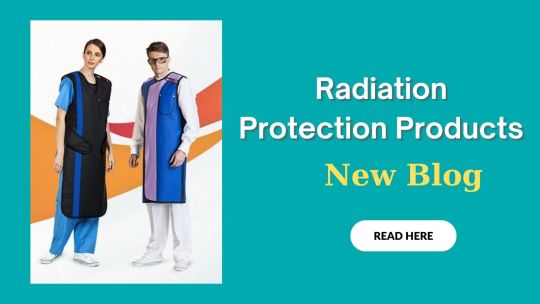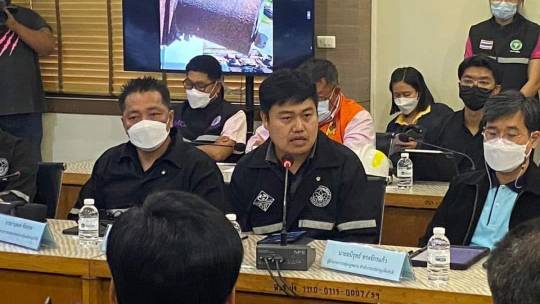#radiationprotection
Text
Revolutionizing Radiation Protection: Trivitron's Cutting-Edge Solutions

🌐 Elevate healthcare safety with Trivitron's advanced radiation protection products! Our lightweight aprons, targeted shielding garments, and electronic dosimeters redefine comfort and precision. 🛡️ Explore cutting-edge solutions for a safer medical environment.
0 notes
Text
Ever wondered how to protect yourself from radiation naturally? Our latest blog post unveils 20 powerful polyphenols and natural compounds that do just that. Explore the world of radioprotective agents like curcumin, EGCG, and more. Dive in to learn how these natural wonders can safeguard your health. 🍅🍵💪
0 notes
Text
Worried about radiation affecting your fertility? Gonad shields offer powerful protection during X-rays, CT scans, and radiation therapy. Discover how they safeguard your reproductive health and the well-being of future generations.
0 notes
Text
Radiation protection
Unseen and potentially harmful, radiation surrounds us daily. Understanding radiation protection is paramount in safeguarding our health and environment.
Delve into the invisible realm of particles and waves that can impact our lives.
Discover how advancements in technology and meticulous safety measures shield us from radiation's subtle threats. Uncover the critical role of protective gear, shielding, and regulations in various industries.
Whether you're a concerned citizen or a professional in the field, exploring the nuances of radiation protection ensures informed decision-making and empowers you to navigate a world permeated by both natural and artificial sources of radiation.
Embark on a journey to safeguard yourself and your community against the unseen forces that demand our attention.
0 notes
Text
Analysis of: "IAEA Comprehensive Report On The Safety Review Of The ALPS-Treated Water At The Fukushima Daiichi Nuclear Power Station" (July 4, 2023)
PDF-Download: https://www.iaea.org/sites/default/files/iaea_comprehensive_alps_report.pdf
Large volumes of contaminated water accumulated at Fukushima Daiichi site post-accident requiring long-term management.
Water is treated using ALPS system but retains tritium, and is stored in tanks posing safety/volume issues.
Japan's plan is to discharge ALPS-treated water to sea after further treatment via gradual batch discharges over 30 years.
IAEA conducted comprehensive review of technical/regulatory aspects of handling and discharging ALPS water.
Assessments addressed source term, facilities/equipment, occupational exposure, environmental impact, emergency response, protection of people/environment.
Potential failure modes were analyzed and redundant safety provisions incorporated.
Monitoring and response plans established to verify impacts remain negligible.
Japan's nuclear regulator independently authorized activities ensuring compliance with stringent regulations.
IAEA independently sampled/analyzed data corroborating negligible predicted impacts.
Activities were evaluated against latest international safety standards for public, workers and environment.
The document provided high confidence that radiation exposures and environmental impacts would be very low and safety optimized.
Here is a summary of the key points from the document in bullet points:
The accident at Fukushima Daiichi Nuclear Power Station in March 2011 resulted in the accumulation of large amounts of contaminated water stored at the site.
In April 2021, the Government of Japan published its Basic Policy on how it would manage this stored contaminated water (called ALPS treated water).
The Basic Policy described that the method selected by the Government of Japan for handling the ALPS treated water was to discharge it into the sea after specific treatment.
Soon after the Basic Policy announcement, the Japanese authorities requested assistance from the IAEA to monitor and review plans and activities relating to the discharge of the ALPS treated water.
The IAEA accepted this request in line with its statutory responsibility and agreed to review the safety aspects of handling ALPS treated water against international safety standards.
The IAEA established a Task Force including IAEA Secretariat experts and independent external experts from various countries to conduct the review.
The IAEA review is focused on assessing whether the actions of TEPCO and Japan to discharge the ALPS treated water are consistent with international safety standards.
The IAEA review includes three major components: assessment of protection and safety, review of regulatory activities and processes, and independent sampling, data corroboration, and analysis.
To date there have been five review missions, six technical reports published, and numerous Task Force meetings to implement the IAEA's review.
This report presents the IAEA's final conclusions that the planned discharge of ALPS treated water is consistent with safety standards.
Here is a summary of the key points made in the document in relation to the accumulation of large amounts of contaminated water stored at the Fukushima Daiichi site:
Groundwater flows into the damaged reactor buildings where it mixes with radioactive debris, becoming contaminated water. This water is collected and stored on site.
Additionally, water used to cool the melted fuel debris keeps it in a stable condition but becomes contaminated. Rainwater also enters the buildings.
Over time, these processes have led to the accumulation of a large volume of contaminated water stored in tanks at the site. As of 2023, around 1.3 million cubic meters of contaminated water was stored in over 1,000 tanks.
Storing such a large volume of highly radioactive water presented increasing risks, difficulties in management, and constrained the pace of broader decommissioning work.
TEPCO developed the ALPS system to remove most radionuclides from the water except tritium. This allowed long-term storage risks to be reduced but led to the issue of how to dispose of the ALPS-treated water.
Japan announced a policy in 2021 to discharge this ALPS-treated water into the sea after further treatment, setting in motion the activities covered in the IAEA's review.
Here is a summary of key points made in the document in relation to ALPS-treated water:
Contaminated water from the plant is treated using the Advanced Liquid Processing System (ALPS) to remove most radionuclides except tritium.
After ALPS treatment, the water is called "ALPS-treated water" and stored in large tanks on site, with around 1,000 tanks containing over 1 million m3 as of 2023.
Japan's 2021 Basic Policy announced the selected method to handle ALPS-treated water was discharge into the sea after meeting regulatory limits, occurring as a series of batch discharges over 30 years.
TEPCO developed facilities and processes for receiving, measuring/confirming, diluting, and discharging batches of ALPS-treated water in a controlled manner.
The Implementation Plan documents the systems, equipment, procedures and controls to facilitate the planned discharges in accordance with regulatory requirements.
A radiological environmental impact assessment was conducted to estimate doses from the planned discharges and assess compliance with requirements.
The IAEA reviewed all aspects of the handling and discharge of ALPS-treated water to assess consistency with international safety standards.
Here is a summary of key points regarding the discharge of ALPS treated water:
Discharges are planned to occur as a series of gradual "batch discharges" over approximately 30 years into the Pacific Ocean.
A discharge facility was constructed offshore including measurement, transfer, dilution and discharge components.
Batches of ALPS treated water will be sampled/analyzed prior to discharge to ensure compliance with regulatory limits.
Treated water will be diluted with seawater achieving >350x dilution before discharge over 1 km into the seabed.
Annual discharge limit of 22 TBq for tritium based on government policy, with 1,500 Bq/L concentration limit.
REIA assessed doses from discharges would be 0.000002-0.00004 mSv/year, well below 0.05 mSv constraint.
Potential exposure scenarios analyzed doses also well below 5 mSv criterion.
Discharges controlled gradually over decades using robust engineered designs and strict operational controls.
Environmental monitoring will verify safety and support ongoing optimization as key element of IAEA review.
Here is my evaluation of how the document addressed radiological impacts:
Radiological impact assessments were based on established international methodologies and models, ensuring scientific rigor.
Conservative assumptions were applied to activity calculations, exposure pathways, dose modeling to avoid underestimation.
Potential impacts to both public and workers from normal operations and accident scenarios were comprehensively evaluated.
Long-term cumulative impacts spanning decades of planned discharges were realistically predicted.
Dose estimates were benchmarked directly against quantitative regulatory criteria and safety standards for public and environment.
Independent confirmatory monitoring by IAEA experts validated the predicted negligible radiological impacts.
Mitigation through engineered controls and operating restrictions minimized already low predicted impacts.
Ongoing environmental monitoring requirements provide reassurance that impacts will remain extremely low.
Emergency response arrangements instill confidence in managing any unforeseen situations.
Overall, the radiological impact assessments appeared to be robust, scientifically sound, transparently supported by evidence, conservatively bounded and directly demonstrating compliance with international safety expectations. The document provided a high level of assurance regarding radiological protection.
Here is a summary of the key points in relation to the assessment of protection and safety:
The IAEA reviewed technical aspects of TEPCO's Implementation Plan and supporting documents.
This included source characterization, safety aspects of discharge approach, occupational exposure, REIA.
The focus was on verifying consistency with relevant international safety standards.
TEPCO considered numerous potential failure modes and consequences through the safety assessment.
Redundancy was incorporated into facility designs and procedural controls.
Calculated doses from normal operations and potential exposures were below thresholds.
TEPCO optimized protection through the ALARA approach required by NRA.
The IAEA concluded protection and safety were consistent with international standards.
However, the work of the IAEA and Task Force will continue applying standards during operations.
So in summary, the IAEA thoroughly assessed technical documentation against safety standards before operations commence, but ongoing assessment will be required once discharges begin.
Here is a summary of key points regarding potential failure modes and consequences:
TEPCO conducted detailed hazard and operability studies to identify potential failure modes.
These included tank leaks, pipe breaks, power outages, earthquakes, extreme weather etc.
Likelihood and impact of failures were quantitatively analyzed.
Defense-in-depth established through multiple preventive/mitigative controls.
For example, tanks have leak detection and secondary containment.
Piping has auto-shutdown valves and seismic resistance.
Generators ensure power backup even in disasters.
Offshore facilities hardened against tsunamis over 15m high.
Consequence modeling showed even worst failures wouldn't exceed dose limits.
Radionuclide behavior understood through dispersion simulations.
Monitoring and response plans in place for any contingencies.
IAEA review confirmed robustness of safety analysis and controls for potential failure modes through the ALARP approach.
So in summary, potential failures were thoroughly analyzed and protective measures instituted to maintain doses ALARA.
Here is a summary of key points regarding monitoring and response plans:
TEPCO established a comprehensive environmental monitoring program.
This involves routinely sampling water, sediment, biota at discharge site and along coast.
On-site, real-time radiation monitoring of tanks and pipes prior to discharge.
Coastal radionuclide monitoring stations were installed by the government.
Monitoring covers tritium, carbon-14 and other potential radionuclides of concern.
Response plans in place to address off-normal monitoring detections.
This includes thresholds that would pause or adjust discharges if exceeded.
Occupational exposure is also carefully monitored for workers.
Comprehensive records and transparent reporting maintained.
International experts collaborating to help verify monitoring validity.
Monitoring crucial for assessing impacts, validating safety, and supporting continuous protection improvement throughout discharge operations.
IAEA review concluded monitoring and response plans will help ensure safety and support decision making through operations.
Here is a summary of key points regarding the review of regulatory activities and processes:
Japan's Nuclear Regulation Authority (NRA) independently regulates the discharge plans.
NRA established stringent technical regulations and licensing requirements.
Technical guidelines provide specific limits, criteria, and assessment methodologies.
Regulatory activities include detailed review of facility designs, safety cases, plans and monitoring programs.
Multiple levels of authorization required including construction approval and operating license.
Rigorous inspections conducted at various stages to verify compliance.
Operators must demonstrate safety and protection before, during and after each discharge.
Regulator holds authority to immediately halt operations if non-compliance found.
Robust enforcement powers and transparency in decision-making.
IAEA review concluded regulatory framework and processes align well with international practices and provide for comprehensive oversight.
Continued regulatory involvement essential throughout duration of discharge activities.
Here is a summary of key points regarding independent sampling, data corroboration, and analysis:
IAEA experts conducted their own sampling/monitoring during missions to FDNPS.
Samples were independently analyzed at third-party IAEA and JAEA laboratories.
This data was used to directly validate TEPCO's monitoring results.
Monitoring equipment was tested, calibrated and cross-checked.
Isotopic and concentration analyses help corroborate source term estimations.
Independent sampling covered areas like discharge facilities, tanks, seawater.
Data allowed Task Force to autonomously assess impacts beyond TEPCO's analyses.
Sample comparisons found TEPCO's data to be accurate and conservative.
International peer reviewers contribute additional checks of sampling methods.
Continued confirmatory sampling during discharge operations is recommended.
Overall, independent data corroboration strengthened safety conclusions and transparency.
So in summary, the IAEA conducted rigorous confirmatory sampling and analysis to autonomously verify key technical inputs and monitoring data.
Here is a summary of key points regarding safety standards:
The IAEA reviewed activities against the latest international safety standards.
Fundamental standards referenced include International Basic Safety Standards (BSS) and ICRP recommendations.
Technical review guidance documents used include TS-G-1.10 and IAEAs RADWASS program.
Nation specific standards established by Japan's Nuclear Regulation Authority also considered.
Standards provide quantitative limits for doses to public and workers as well as discharge criteria.
Standards cover all aspects from facility design to environmental monitoring to emergencies.
Compliance with standards ensures protection of people and environment is optimized.
Conservative margins built into standards to account for uncertainties.
Conclusions state activities are adequately consistent with requirements in safety standards.
Ongoing adherence to standards during operations is emphasized for ongoing safety.
So in summary, the IAEA assessed all technical aspects against the latest global consensus safety standards framework.
Here is a summary of key points regarding protection of people and the environment:
The overarching purpose of the review was to verify protection of people and the environment.
Protection is optimized through compliance with limits and criteria in international safety standards.
Doses to the public and workers from all situations assessed were well below regulatory limits.
Radiological impacts on the local community and along discharge plumes were estimated to be negligibly small.
Potential exposure pathways through air, water, soil, food were comprehensively analyzed.
Safety assessments considered long-term cumulative impacts over decades of discharge operations.
Environmental monitoring programs will confirm negligible effects as verified by IAEA sampling.
Ongoing research continues enhancing understanding of radionuclide behavior in the oceans.
Emergency response plans in place to promptly deal with any unplanned discharges.
Overall the IAEA concluded protection of people and the marine environment was adequate and consistent with standards through all phases reviewed.
So in summary, the review centered on thoroughly demonstrating adequate radiological protection as the overriding priority.
Here is my evaluation of how the document addressed protection of people and the environment:
Protection was the fundamental priority underpinning all technical assessments and regulatory requirements.
A comprehensive and conservative safety case approach demonstrated how risks would be minimized to levels as low as reasonably achievable (ALARA principle).
Potential impacts via multiple exposure pathways and over the long operational time frame were thoroughly quantified.
Doses were shown to be not only below regulatory limits but also at trivial fractions of the limits, ensuring large margins of protection.
Engineering and administrative controls along with environmental monitoring provide robust assurance of safety.
Rigorous independent review and sampling by international experts added confidence in the protective conclusions.
Consultation with stakeholders demonstrated inclusive consideration of all societal concerns regarding protection.
Ongoing oversight responsibilities were clearly defined to sustain protection throughout operations.
Overall, by anchoring assessments directly to international safety standards, utilizing a systematic safety case methodology, and subjecting the results to rigorous independent scrutiny, the document provides a high level of assurance that the health and safety of people and environmental protection were comprehensively addressed in compliance with global expectations.
Based on its content and purpose, I would classify this IAEA document as a technical report.
Some indications that led me to this conclusion:
It provides explanations and insights over a broad range of technical topics relevant to understanding the safety of discharging ALPS treated water.
The level of technical detail included is intended to make the conclusions accessible to specialists and those with non-technical backgrounds.
It presents the final review conclusions and findings of the IAEA technical assessment, intended as a comprehensive summary.
It includes references, annexes with contextual/explanatory information, and lists of contributors consistent with a reference/scientific report.
The intended audience appears to include technical experts, regulators, as well as a broader international audience interested in the topic.
Therefore, while also providing a conclusion and findings, the style and depth of content is consistent with a technical report genre seeking to explain the technical review process comprehensively for varied audiences.
Here is an evaluation of the quality of the document based on several factors:
Accuracy:
Details are supported by evidence from documentation reviewed.
Conclusions align with standards and are factually logical.
Completeness:
All key safety topics within scope are addressed in necessary depth.
Relevant international standards are comprehensively considered.
Clarity:
Technical explanations are easy to understand for non-experts.
Structure and flow allow logical following of conclusions.
References:
Supporting documents and technical bases are well cited.
Published guidance documents inform discussions.
Balance:
Multiple viewpoints are represented fairly in discussions.
Uncertainties and limitations are acknowledged.
Overall, I would assess the quality of this technical report as high. It demonstrates a thorough review supported by accurate details and logical conclusions. Complex topics are made accessible, and an inclusive approach has been taken by considering diverse technical perspectives. The document establishes the IAEA's final thorough review of this safety issue at a level consistent with relevant international standards.
Based on its content and purpose, this IAEA technical report falls strongly on the side of science, empirical facts and objective analysis rather than fiction, anecdote, opinion or subjectivity.
Specifically:
The report aims to objectively assess whether planned discharges align with safety standards, not advance an opinion.
Discussions are firmly grounded in technical documentation and empirical inspection/corroboration findings, not speculation.
Conclusions represent syntheses of facts from hundreds of pages of review materials, not personal views.
Diverse expertise is brought to bear ensuring multi-perspective technical rigor, not singular subjectivities.
Stance maintains impartiality/independence as per the IAEA's statutory functions and established review process.
Quantitative data, calculations and technical language are features, not qualitative speculation.
While some assumptions and uncertainties are inherent, the report's focus, depth of analyses, independence and reliance on empirical evidence place it strongly in the domain of objective, factual technical assessment consistent with its purpose and impartial role. Its conclusions represent a reality-grounded synthesis for the international technical community.
In summary, I would evaluate the comprehensive report as being more closely aligned with science, facts and objectivity than personal opinions, fiction or subjectivities, given its mandate, multi-perspective expertise, abundance of evidence-based discussions.
Based on reviewing the content and stated purpose of the document, I would characterize its perspective as neutral and independent.
Some specific indicators that support this assessment include:
The report is published by the IAEA, an internationally recognized technical organization governed by an independent Board of Governors representing Member States.
The review is led by an independent Task Force comprised of IAEA and third-party experts providing objective scientific/technical advice.
Discussions are framed around an impartial assessment of consistency with international safety standards, not advocacy of any position.
Multiple technical perspectives are represented to ensure a well-rounded evaluation that considers diverse viewpoints.
Factual language and objective analysis are used without emotive terms or implied policy endorsements.
Conclusions represent a distillation of evidence rather than predetermined positions.
The scope is clearly defined as technical safety review, not commentary on broader political/social issues.
Overall, the content, structure and stated mandate/purpose of the report suggest it aims to present fact-based technical findings in an objective, neutral manner suitable for reference by a range of international audiences. The document appears to maintain an appropriately independent and impartial technical perspective.
Based on the information provided in the document, here is an evaluation of the situation it describes:
Context:
Large volumes of ALPS treated water accumulated at FDNPS following the 2011 nuclear accident.
Japan announced a policy in 2021 to discharge this water into the sea after further treatment.
Japan requested IAEA review the safety aspects of handling/discharging this water.
Complexity:
Multidisciplinary technical issues spanning treatment systems, discharges, impacts assessment.
Long-term nature of proposed discharges over several decades adds complexity.
Unique circumstances of FDNPS accident and site decommissioning context.
Progress:
Iterative approach taken, incorporating multiple stakeholder perspectives over time.
Technical and regulatory topics addressed in depth through review missions/reports.
Planning/reviews demonstrate intention to apply global safety standards.
Outcomes:
Comprehensive documentation of technical review conclusions up to this point.
Findings indicate approach/activities to date align with safety standards requirements.
Provides global evidentiary basis for understanding safety aspects to this point.
In summary, the document effectively evaluates a complex technical situation encompassing multiple interests over time. The iterative approach taken supports continued progress consistent with safety.
The main stakeholders affected by this IAEA comprehensive report include:
Government of Japan - As the requesting party and responsible authority for managing the ALPS treated water and decommissioning activities.
TEPCO - As the licensee responsible for safety of the discharge activities at FDNPS.
NRA - As the independent nuclear regulator that must authorize the activities.
Local communities around FDNPS - As parties most directly impacted by any unintended consequences.
Broader Japanese public - With significant interest in the open & transparent management of the issues.
Neighbouring countries - With interested in verifying negligible transboundary impact.
Global nuclear community - Interest in safety-focused resolution setting precedent.
Environmental groups - Concerned with radiological impact on ecology and marine life.
Scientific community - Interest in data validation and furthering protection knowledge.
This is a reasonably comprehensive list of key stakeholders. Evaluation suggests their interests are also fairly represented through: discussion of technical topics; consideration of perspectives; iterative improvements incorporating feedback; and commitment to transparency. Overall engagement with this diverse set of stakeholders has been thoughtful and considerate throughout the IAEA's review.
In evaluating this document in relation to the known consensus in the international community and technical literature on nuclear safety assessments, I note the following:
The document draws heavily on the IAEA's international safety standards, which are themselves developed through extensive international consensus processes.
The approach taken is consistent with internationally accepted methodologies in key documents like GSG-10 and SRS-19 for REIAs and source terms.
The tools and models used align with those internationally validated and used, such as ORIGEN.
The document appropriately considers international consensus documents like ICRP recommendations on reference animals/plants and other protection aspects.
Results are compared directly to international standards without deviation or subjective interpretation.
International peer reviewers involved throughout strengthens global technical consensus considerations.
Publication under the IAEA's auspices lends credibility through their role as custodian of global standards.
Overall, by directly utilizing input from the international technical community itself and anchoring assessments against the globally harmonized safety standards framework, the document demonstrates a strong correlation to the recognized consensus in the field. No technical discordance was apparent.
After carefully reviewing the document, I did not find any clear instances of logical fallacies. Some notes:
The conclusions drawn appear well supported by evidence presented and discussions held. There are no apparent gaps or leaps made in reasoning.
The process of undertaking expert technical review missions, publishing intermediate progress reports, and facilitating public feedback mechanisms helps reduce the risk of blind logical errors.
Discussions focus on impartial assessments of technical criteria compliance rather than opinions.
Diverse expertise incorporated helps balance any risks of perspective biases, and multiple iterations allow refinement.
Quantitative assessments are data-driven without subjective interpretations of results.
Conservative assumptions used minimize potential of overstating safety case.
Large volume of review materials and iterative approach facilitate identification of inconsistencies.
In summary, given the impartial, evidence-based nature of the analyses, engagement of independent multidisciplinary experts, consideration of diverse technical comments over many iterations, and publication under the IAEA banner - I did not find logical fallacies present in the comprehensive report. The assessment and conclusions appear well-supported and free of substantive logical flaws.
Based on my review, the document appears to have been produced and presents its content in an ethical manner:
Transparency - The approach, sources, assumptions and limitations are clearly explained.
Impartiality - The assessments avoid bias and advocate no particular position or recommendations.
Integrity - The conclusions seem logically consistent with evidence presented and expertise applied.
Accuracy - Factual information is properly distinguished from expert judgment or estimation.
Objectivity - Technical discussions are data-driven without subjective slants or embellishments.
Prudence - Conservative default positions minimize risk of underestimating safety aspects.
Responsiveness - The document reflects multiple interactions and iterations to address feedback.
Inclusiveness - Diverse technical viewpoints are represented to provide balanced perspectives.
Overall, through its evidence-based analyses, transparent discussions of uncertainties, utilization of multidisciplinary expertise, and iterative approach responsive to comments, the document demonstrates ethical conduct of the IAEA’s safety review consistent with its independent and impartial role. No potential ethical issues or violations were apparent to me based on the content and stated purpose of the document.
p2hc4W70tZwOoA8Ne10j
#Fukushima#FukushimaDaiichi#FukushimaDisaster#FukushimaWater#ALPStreatedwater#TritiatedWater#Radwaste#NuclearDecommissioning#TEPCO#JapanNRA#IAEA#NuclearSafety#RadiationProtection#EnvironmentalImpact#MarinePollution#NuclearRegulation#IndependentReview#TechnicalReview#SafetyStandards#RadiologicalRisk#PublicHealth#OceanDischarge#NuclearTransparency#NuclearStakeholders#NuclearAccounting#NuclearOversight#FukushimaRecovery
0 notes
Text
Dr. Sarath Chandra Reddy | Top Radiation Oncology In Hyderabad
Dr. Sarath Chandra Reddy Top Radiation Oncology In Hyderabad is renowned for his expertise in using radiation therapy to treat cancer and his compassionate patient care.

#sarathchandrareddy#radiationoncology#radiationtherapy#radiation#radiationsafety#radiationprotection#kaizenoncologynetwork#kaizenoncology#cancertreatment#cancerspecialist#hyderabad
0 notes
Photo

Thailand has found its missing radioactive cylinder. That’s where the good news ends
Thai authorities found a radioactive cylinder that was reported missing earlier this month. The bad news is that the object was no longer intact.Read more...
https://qz.com/thailand-radioactive-cylinder-found-foundry-1850242618
#ionizingradiation#physicalsciences#cobalt 60#permsuksutchaphiwat#radiationprotection#ronnarongnakornjinda#radioactivewaste#radiobiology#radioactivity#radioactivecontamination#nationalpowerplant5aco#kittiphanchitpentham#nationalpowersupplypublicco#nucleartechnology#caesium#nuclearphysics#opaskarnkawinpong#caesium 137#pennapakanchana#Ananya Bhattacharya#Quartz
0 notes
Text
Dr. Syed Touseef Ahmed | Radiation Oncology In Hyderabad
If you're searching for a skilled radiation oncologist in Hyderabad, look no further than Dr. Syed Touseef Ahmed. With years of experience and a dedication to providing the highest quality of care, Dr. Syed Touseef Ahmed is a trusted expert in the field of radiation oncology. He specializes in the diagnosis and treatment of cancer using advanced radiation therapy techniques, including stereotactic body radiation therapy (SBRT), intensity-modulated radiation therapy (IMRT), and more. Dr. Syed Touseef Ahmed works closely with other cancer specialists to develop personalized treatment plans that are tailored to each patient's unique needs and circumstances. With a commitment to providing compassionate and effective care, Dr. Syed Touseef Ahmed is here to help you on your cancer treatment journey. Dr. Syed Touseef Ahmed Radiation Oncology In Hyderabad, Contact us today to schedule a consultation and learn more about our radiation oncology services.

#DrSyedTouseefAhmed#Hematology#radiationoncology#radiationtherapy#rediation#radiationprotection#kaizenoncologynetwork#kaizenoncology#cancertreatment#cancerspecialist#hyderabad
0 notes
Photo

Respect 🙏🏻 #couragousgeneration #japaneseculture #japanlife #fukushima #nuclearpowerplant #radiationprotection #protectingthelegacy #kindness #compassioninaction (at Catalina Foothills, Arizona) https://www.instagram.com/p/Coa58UlPliFjmO7Dz3ay8KLescRfgxlfHEUNNs0/?igshid=NGJjMDIxMWI=
#couragousgeneration#japaneseculture#japanlife#fukushima#nuclearpowerplant#radiationprotection#protectingthelegacy#kindness#compassioninaction
1 note
·
View note
Text
Dr. Sarath Chandra Reddy | Top Radiation Oncology In Hyderabad

Dr. Sarath Chandra Reddy Top Radiation Oncology In Hyderabad, He has a deep understanding of the disease and its treatment, and he is committed to providing the best possible care to his patients. If you or a loved one has been diagnosed with cancer, contact Dr. Sarath Chandra Reddy to learn more about your treatment options.
#sarathchandrareddy#radiationoncology#radiationtherapy#radiation#radiationsafety#radiationprotection#kaizenoncologynetwork#kaizenoncology#cancertreatment#cancerspecialist#hyderabad
0 notes
Link
𝐑𝐀𝐃𝐈𝐀𝐓𝐈𝐎𝐍
Watch this video to know more about Radiation.
Click the below link to watch our latest videos on health and safety👇🏻
🔗https://www.youtube.com/c/MalayaliSafetyGuru
💟𝓟𝓵𝓮𝓪𝓼𝓮 𝓛𝓲𝓴𝓮👍🏻, 𝓢𝓱𝓪𝓻𝓮🤝 𝓪𝓷𝓭 𝓢𝓾𝓫𝓼𝓬𝓻𝓲𝓫𝓮🔔 𝓽𝓸 𝓰𝓮𝓽 𝓶𝓸𝓻𝓮 𝓲𝓷𝓯𝓸𝓻𝓶𝓪𝓽𝓲𝓸𝓷💟
#malayalisafetyguru#radiation#radiationtypes#health and safety#radiationprotection#radiationzone#safety
0 notes
Text
The thyroid, a butterfly-shaped gland in your neck, plays a vital role in metabolism. But it's also highly sensitive to radiation. This guide empowers you to shield your thyroid during medical procedures with:
0 notes
Text
0 notes
Text
Wear a good lead suit to avoid or minimize the potential health hazards of rays!

#rfcage #radiationprotection #radiationsafety #radiation #radiationtherapy #rfengineering #rfdesign #rfidsolutions #rfidtechnology #rfi #shielding #shieldinsuranceagency #shield #shielded #rfshielded #mriscan #mridoor #rfchambers #chambersolutions
rfcage #radiationprotection #radiationsafety #radiation #radiationtherapy #rfengineering #rfdesign #rfidsolutions #rfidtechnology #rfi #shielding #shieldinsuranceagency #shield #shielded #rfshielded #mriscan #mridoor #rfchambers #chambersolutions #mrisolutions #rfcage #coppergasket #berylliumcopperstrips #BeCufigures #shieldedfigurestocks #conductivefoam #conductivefabric #coppertapewithconductiveadhesive #copperwiremesh #copperwool #shieldedcabinet #shieldeddoor #conductiverubber #knittedwiremesh #brassmesh #shieldedwindow
1 note
·
View note
Photo

Thailand’s mad hunt to find a missing radioactive cylinder has made no progress so far
Last Friday (Mar. 10), a radioactive cylinder was reported missing in Thailand. Nearly a week on, it’s still nowhere to be seen.Read more...
https://qz.com/thailand-radioactive-cylinder-missing-caesium-137-1850232039
#kittiphanchitpentham#physicalsciences#cobalt 60#nationalpowersupplypublicco#radiationprotection#woolsey#radioactivewaste#radiobiology#mongkolthopao#chitpentham#radioactivity#nuclearphysics#radioactivecontamination#tube#chemistry#ionizingradiation#hazardouswaste#caesium 137#pennapakanchana#Ananya Bhattacharya#Quartz
0 notes
Text
Safeguarding Health: How to Maintain and Dispose of Lead Aprons
Protecting lives from radiation exposure is paramount in medical technology. Beyond visible effects like allergies and burns, radiation can harm DNA, affecting future generations. Radiation shields are vital. Cleaning lead aprons is key:
1. Inspect for damage.
2. Clean with a damp cloth and mild detergent.
3. Store properly.
Dispose responsibly:
1. Contact recycling companies.
2. Consult hazardous waste carriers.
3. Check with local landfill.
Regular checks every 18-24 months are crucial for safety. Visit Trivitron Healthcare for radiation protection accessories. Safety matters. #RadiationProtection #LeadAprons #HealthcareSafety

0 notes